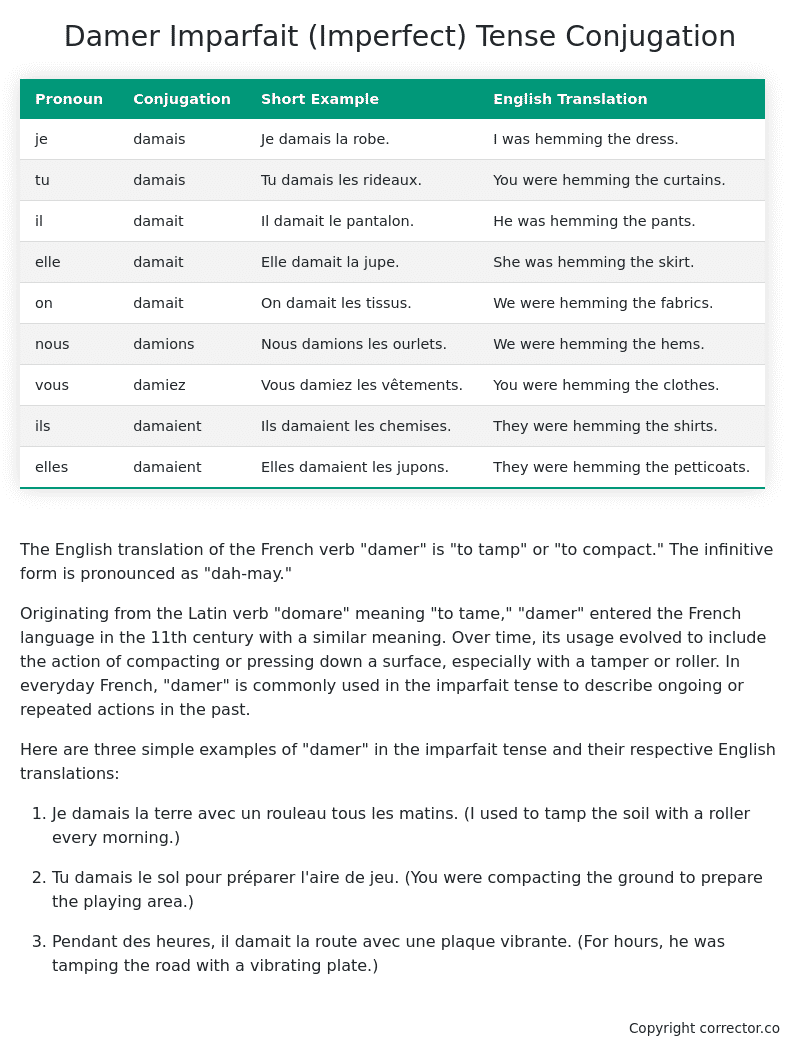Imparfait (Imperfect) Tense Conjugation of the French Verb damer
Introduction to the verb damer
The English translation of the French verb “damer” is “to tamp” or “to compact.” The infinitive form is pronounced as “dah-may.”
Originating from the Latin verb “domare” meaning “to tame,” “damer” entered the French language in the 11th century with a similar meaning. Over time, its usage evolved to include the action of compacting or pressing down a surface, especially with a tamper or roller. In everyday French, “damer” is commonly used in the imparfait tense to describe ongoing or repeated actions in the past.
Here are three simple examples of “damer” in the imparfait tense and their respective English translations:
-
Je damais la terre avec un rouleau tous les matins.
(I used to tamp the soil with a roller every morning.) -
Tu damais le sol pour préparer l’aire de jeu.
(You were compacting the ground to prepare the playing area.) -
Pendant des heures, il damait la route avec une plaque vibrante.
(For hours, he was tamping the road with a vibrating plate.)
Table of the Imparfait (Imperfect) Tense Conjugation of damer
| Pronoun | Conjugation | Short Example | English Translation |
|---|---|---|---|
| je | damais | Je damais la robe. | I was hemming the dress. |
| tu | damais | Tu damais les rideaux. | You were hemming the curtains. |
| il | damait | Il damait le pantalon. | He was hemming the pants. |
| elle | damait | Elle damait la jupe. | She was hemming the skirt. |
| on | damait | On damait les tissus. | We were hemming the fabrics. |
| nous | damions | Nous damions les ourlets. | We were hemming the hems. |
| vous | damiez | Vous damiez les vêtements. | You were hemming the clothes. |
| ils | damaient | Ils damaient les chemises. | They were hemming the shirts. |
| elles | damaient | Elles damaient les jupons. | They were hemming the petticoats. |
Other Conjugations for Damer.
Le Present (Present Tense) Conjugation of the French Verb damer
Imparfait (Imperfect) Tense Conjugation of the French Verb damer (You’re reading it right now!)
Passé Simple (Simple Past) Tense Conjugation of the French Verb damer
Passé Composé (Present Perfect) Tense Conjugation of the French Verb damer
Futur Simple (Simple Future) Tense Conjugation of the French Verb damer
Futur Proche (Near Future) Tense Conjugation of the French Verb damer
Plus-que-parfait (Pluperfect) Tense Conjugation of the French Verb damer
Passé Antérieur (Past Anterior) Tense Conjugation of the French Verb damer
Futur Antérieur (Future Anterior) Tense Conjugation of the French Verb damer
Subjonctif Présent (Subjunctive Present) Tense Conjugation of the French Verb damer
Subjonctif Passé (Subjunctive Past) Tense Conjugation of the French Verb damer
Subjonctif Imparfait (Subjunctive Imperfect) Tense Conjugation of the French Verb damer
Subjonctif Plus-que-parfait (Subjunctive Pluperfect) Tense Conjugation of the French Verb damer
Conditionnel Présent (Conditional Present) Tense Conjugation of the French Verb damer
Conditionnel Passé (Conditional Past) Tense Conjugation of the French Verb damer
Conditionnel Passé II (Conditional Past II) Tense Conjugation of the French Verb damer
L’impératif Présent (Imperative Present) Tense Conjugation of the French Verb damer
L’impératif Passé (Imperative Past) Tense Conjugation of the French Verb damer
L’infinitif Présent (Infinitive Present) Tense Conjugation of the French Verb damer
L’infinitif Passé (Infinitive Past) Tense Conjugation of the French Verb damer
Le Participe Présent (Present Participle) Tense Conjugation of the French Verb damer
Le Participe Passé (Past Participle) Tense Conjugation of the French Verb damer
Struggling with French verbs or the language in general? Why not use our free French Grammar Checker – no registration required!
Get a FREE Download Study Sheet of this Conjugation 🔥
Simply right click the image below, click “save image” and get your free reference for the damer imparfait tense conjugation!

Damer – About the French Imparfait Tense
NOTE: To take a deep dive into all the French tenses then see our article on Mastering French Tense Conjugation.
Formation of the Imparfait Tense
For regular -er verbs:
For regular -ir verbs
For regular -re verbs
Common Everyday Usage Patterns
Description of Past Habits
Background Information
Mental and Emotional States
It’s employed to express emotions, thoughts, or physical sensations in the past. For example: “J’étais content quand il est arrivé.” (I was happy when he arrived.)
Ongoing Actions
Points to Note About the Imparfait Tense
Passé Composé vs. Imparfait
Conditional
Si Clauses
Narration
I hope you enjoyed this article on the verb damer. Still in a learning mood? Check out another TOTALLY random French verb imparfait conjugation!


